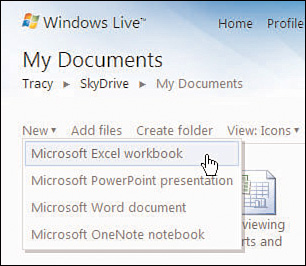3. Saving to SkyDrive from Excel
Save a file from Excel directly to your SkyDrive by
choosing File, Save & Send, Save to Web. Excel attempts to log you
in automatically, but if it can’t, click the Sign In button, shown in Figure 3,
to bring up the .NET Passport Wizard, which will take you through the
steps to associate your Windows Live ID to your Windows User Account.
After following the wizard the first time, you will always be linked to
your SkyDrive.

4. Creating a New Workbook
You aren’t limited to workbooks created previously
in Excel on your desktop. You can create a new workbook online and
download it when you return to the office.
Creating a New Workbook
To create a new workbook on your SkyDrive, follow these steps:
1. | Click the folder you want the workbook in.
|
2. | Click New, Microsoft Excel Workbook (see Figure 4).

|
3. | Enter the name of the workbook and click Create. Windows Live automatically appends the file extension (xlsx) for you.
|
5. Opening a Workbook
When you select a folder, you’ll see all the workbooks in the folder. Select a workbook to see the available options.
When you select to View a workbook, it’s opened as a
read-only file. Unlike read-only mode on the desktop version of Excel,
where you can make changes and not save them to the original file, you
cannot make changes while in View mode. You can only look at the
workbook, as shown in Figure 5.

Select Edit to access the full Excel Web App functionality and make changes to a workbook, as shown in Figure 6. Changes are automatically saved as they are made.

6. Saving a File to Your Local Drive
Eventually, you will want to work on a workbook saved locally. This can be done in several ways:
Before you open the workbook, select Download from the menu.
While viewing or editing the workbook, select the File tab to reveal the following options (see Figure 7):
Open in Excel— Open the workbook locally in Excel.
Download a Snapshot— Download a copy of the workbook containing only its values, formatting, and charts.
Download a Copy— Download the entire workbook.

The options Save As and Save a Copy create an online copy of the workbook with a new name in the same folder as the original.